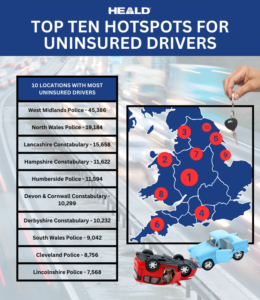Need to speak to us? Here’s our most useful number and email addresses
Sales: sales@heald.uk.com
General information: info@heald.uk.com
Marketing: marketing@heald.uk.com
Need to speak to us? Here’s our most useful number and email addresses
Sales: sales@heald.uk.com
General information: info@heald.uk.com
Marketing: marketing@heald.uk.com

Insurance premiums have skyrocketed in the last year, with the average comprehensive cover 25% more expensive in 2023 than in 2022, according to the Association of British Insurers (ABI).
The surge in premiums has highlighted the potential for an increase in uninsured motorists. The Motor Insurers Bureau Scheme (MIB) recently estimated that one million uninsured drivers were on UK roads. With more drivers like this, premiums will increase again and pose a significant risk to other drivers, pedestrians, and businesses/buildings in high-traffic areas. MIB also revealed that every 20 minutes, someone in the UK falls victim to an uninsured driver or a hit-and-run incident.
Considering these statistics, we developed a new study to reveal the UK’s top ten uninsured driver hotspots according to the number of vehicles police constabularies seized between 2019 and 2023. We wanted to investigate this to identify areas that would benefit from extra policing, hostile vehicle mitigation systems, or public awareness campaigns.
Our findings are based on insight obtained through a Freedom of Information (FOI) request sent to 47 police constabularies nationwide.
Based on our findings, the ten worst offending regions in the UK for driving without insurance according to the total number of vehicles seized within the five-year period include:
1. West Midlands Police – 45,386
2. North Wales Police – 19,184
3. Lancashire Constabulary – 15,658
4. Hampshire Constabulary – 11,622
5. Humberside Police – 11,594
6. Devon and Cornwall Constabulary – 10,299
7. Derbyshire Constabulary – 10,232
8. South Wales Police – 9,042
9. Cleveland Police – 8,756
10. Lincolnshire Police – 7,568

West Midlands takes the top spot for the most vehicles seized by police due to driving without insurance (45,386). Of the 45,386 vehicles seized, 11,302 were categorised as ‘medium commercial’, e.g. vehicles often used as work vans.
North Wales Police seized 19,184 vehicles within the five years, while South Wales Police caught 9,042 individuals without insurance. Insurance costs in Wales reached a record high in 2023, soaring by 53% according to a recent price index³.
Other uninsured vehicle hotspots include Lancashire (15,658), Hampshire (11,622), Humberside (11,594), Devon and Cornwall (10,299), Derbyshire (10,232), Cleveland (8,756), and Lincolnshire (7,568).
While multiple factors may lead someone to forego insuring their vehicle, including recent increases in costs, some individuals opt out of insurance as part of criminal activities they intend to carry out.
The biggest reason a criminal might choose not to insure their vehicle is to avoid detection. Insuring a vehicle requires providing personal information and vehicle details, which could increase the risk of detection by the police. Alongside this, criminals intending to cause harm or destruction may believe that having insurance would not benefit them in achieving their objectives. Instead, they may see driving without insurance as a way to avoid accountability or financial repercussions for their actions.
The sharp rise in insurance costs undoubtedly adds pressure for drivers, especially younger ones, to consider driving without insurance. It’s also clear that driving without insurance can sometimes go beyond financial constraints, and, unfortunately, it’s connected to criminal activity. However, it’s important to recognise the significant risks that uninsured drivers pose to pedestrians and property, whether an intentional attack or an accidental incident.
The number of vehicles seized over the last five years is shocking, and authorities and insurance companies should assess how they can better collaborate to reduce the number of uninsured drivers on the road.
This could include increasing road policing activity, sharing data to identify uninsured drivers quickly, and implementing ANPR cameras in the highest offending areas. Alongside this, authorities and insurers should consider coming together to drive public awareness campaigns, such as the ‘Week of Action’, which took place in 2021, developed by the Motor Insurer’s Bureau, National Road Policing Operations, and Intelligence and Investigations.
These stark figures should also prompt local authorities to consider anti-ram bollards and traffic bollards in areas identified as high-risk for uninsured driving. Installing perimeter protection promotes feelings of security and peace of mind that people and premises will be protected.
Whether you aim to guard against uninsured motorists or establish perimeter protection against various vehicle incidents, exploring the option of anti-ram bollards proves beneficial. Whether you represent a local authority seeking to improve pedestrian safety or you’re a business owner aiming to create a barrier between your building and nearby high-traffic areas, the following security bollards should be considered:
Matador: Crash-tested to various IWA standards, the Matador effectively stops vehicles and preserves underground utilities without requiring repairs post-impact. Its sliding feature facilitates constant pedestrian access and allows passage for authorised vehicles, ensuring safety with a flat surface design and visible moving parts to minimise accidental damage. The Matador’s versatility extends to its installation options, which are suitable for locations where traditional bollards may not be feasible. Whether surface-mounted for temporary events or flush-mounted for permanent fixtures, the Matador offers seamless integration with various covers to suit any environment, from historic settings to modern urban landscapes. Additionally, an optional architectural paving tray system enables easy integration with existing streetscapes, making the Matador an ideal choice for diverse security needs.
Synergy: Our Bridge Bollard System, originally designed to protect bridges from hostile vehicle attacks, offers versatile security solutions applicable to urban areas and footways. Comprising nine interconnected fixed bollards, Synergy requires no pinning and can be expanded by adding additional bollards. Crash-tested to halt a 7.2-tonne truck travelling at 48 kph, the system’s patented technology anchors bollards upon impact, preventing vehicle penetration with minimal encroachment onto the protected area. Deployable in approximately 45 minutes without needing a concrete base, the system offers ease of installation and transportation, facilitated by its modular design and bolt-on assembly. Various bollard covers are available to suit different environments, making the Bridge Bollard System a comprehensive solution for different security needs.
To learn more about which perimeter protection solutions would be suitable for your requirements, please contact our friendly team today: https://www.heald.uk.com/get-in-touch/

